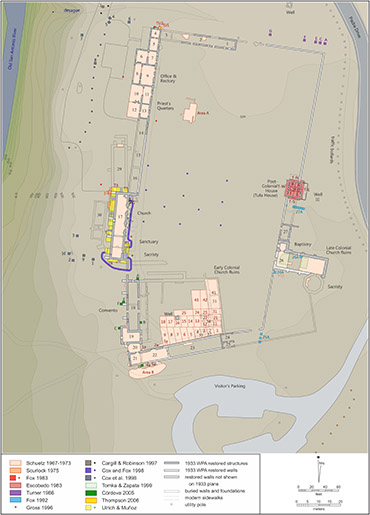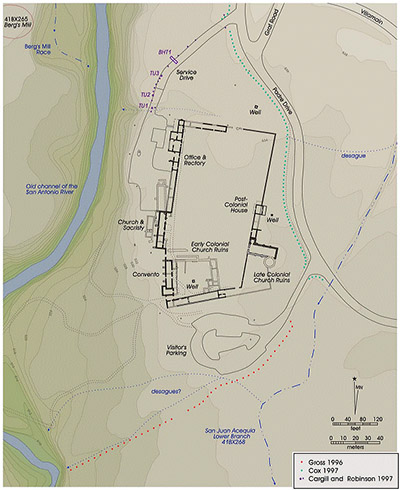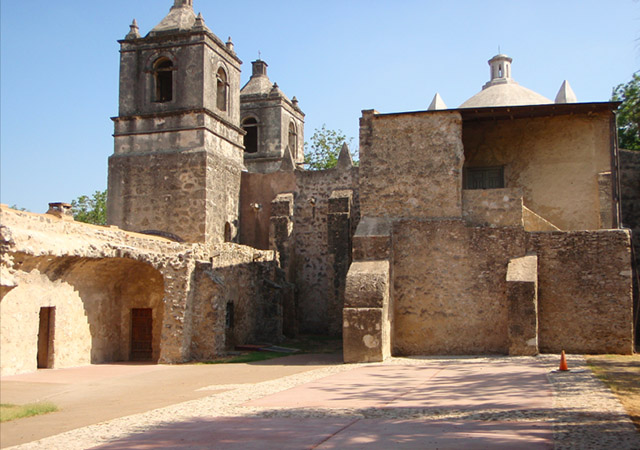Artifact Gallery
The artifact gallery contains images of lithics and artifacts recovered from Mission San Juan Capistrano. Visit the Mission San Juan Capistrano gallery page to view those artifacts and photos from the excavation.
In the Beginning
Spain instituted the Spanish missions in order to protect Spanish interests in Texas and to Christianize and assimilate the indigenous populations to Roman Catholic and Spanish customs. The process also served to populate Texas with converts rather than reluctant immigrants from Spain. Politically, the missions and presidios served to protect the eastern frontier from French occupied Louisiana by building missions and presidios in the hinterlands other Spanish colonists refused to inhabit. The missionaries and soldiers who settled these areas assembled the native population, forced them into sedentary lives, taught them European traditions, and put them to work serving the missionaries in the fields and inside the compound.
Mission San Juan Capistrano was one such mission established in 1716 as San José de los Nazonis to defend against French encroachment from the east. In 1731, Mission San Juan and the other east Texas missions moved to the San Antonio area after the French threat subsided and the operation costs became prohibitive. March 5, 1731 Franciscans from the Colegio de la Santa Cruz de Querétaro founded Mission San Juan Capistrano on the San Antonio River.
The Native Groups
The friars of Mission San Juan Capistrano attempted to evangelize the local population occupying present-day San Antonio, which during the early sixteenth century included primarily Coahuiltecan-speaking peoples. Specifically these were the Borrado, Camasuqua, Chayopine, Guanbraunta-Aiaguia, Malaquita, Orejone, Pacao, Pajalat, Pamoque, Pana, Pasnacan, Peana, Peguique, Pitalac, Sarapjon, Tacame, Taguaguan, Tilijae, Tinapihuaya, Venado, and Viayan (Campbell 1988:90, Carlson 1994:77, Mitchell 1980). Members of the individual tribes resided at the mission periodically during the mission’s history. They were not all consistently present or present in large numbers. They brought with them knowledge and skills of ceramic and lithic technologies as exhibited in their material cultures that today provides a rich archaeological record of the brief co-existence of Native Americans and Spanish Colonists.
The Mission Compound
The bulk of the archaeological excavation at Mission San Juan Capistrano has been in pursuit of the compound’s building sequence. These records with the aid of historical documents are the sources of the known use and dates of the buildings. Construction of the compound likely began immediately after its foundation, though the first recorded history is not available until 1745. Major renovations were happening across the compound in 1772 though smaller scale building renovations occurred throughout the history of the mission.
The earliest mention of structures occurred in 1745, fourteen years after mission’s foundation in San Antonio. At that time, only a group of jacals providing shelter for the natives, a stone building for the missionaries’ quarters, a store room, granary, and jacal church stood at the mission. These made up a row of buildings across the west side of the compound. The storeroom eventually became the church that is used today. Two rooms of the friary built south of the storeroom function as the gift shop and museum today. The first church at the mission was a jacal, not a permanent structure, but reportedly sat on the east end of southern wall. These rooms represent the first structures built on the mission compound built prior to 1745. The jacal church was replaced with a stone church by 1756. This church saw a number of renovations including a new sacristy.
The convento compound sits at the southwest corner of the main compound. The convento contained cells for the missionaries and a weaving workshop added between 1756 and 1759. The convento also underwent many renovations that included additional cells, covered walkways and entrances, patios, and Roman arches. By 1756, the core of the building complex along the south wall included an office, refectory, kitchen, and overlapped with rooms from the convento, specifically the weaving workshop. By 1772, this complex grew to include a gateway, additional storerooms, infirmary, guestroom, offices, and a chicken house. These additions were built over older foundations making the building sequence and footprint difficult to discern on this part of the grounds.
The east row of buildings included a church and sacristy and the postcolonial Tufa house. In 1765, thirty-four years after the founding of the mission, construction of pueblos began to replace the jacals that previous housed the native residents of the mission but was still underway by 1772. Historic journals described 15 new stone houses sheltering 60 families. The remaining families still inhabited the jacals. Both the old and new housing was enclosed by a stone wall within the mission compound.
Population Trends
A number of problems effected the population of the native groups at Mission San Juan Capistrano. Foremost during the early years was desertion prompted by cultural differences, disease, lack of supplies and raids from neighboring Apache groups from the Edwards Plateau. Understandably, mission life was difficult to adjust to and many people left to return to their native traditions. Sometimes desertion was only temporary. Natives left seasonally to harvest traditional foods like prickly pear during the long process of assimilation. Some reports indicate the natives moved from one mission to the next trying each out before choosing a place to settle. Population increased at all the missions during the mid 1700s when the Lipan Apache moved from the Edwards Plateau motivating the local people to enter the missions for safety (Campbell 1988).
Throughout the mission’s history, the population has fluctuated. Records show a peak of 265 residents in 1756 with a gradual decline through periods of social unrest and epidemics until secularization in 1794 (Schuetz 1980a). Population numbers are problematic especially after 1790 when the census rules changed to specifically include only those individuals residing within the compound walls. Biases in the historical record are always a consideration, in this case with respect to the mission population where the number of converts in part gauges the mission’s success. After secularization, twelve Native American heads of households received land and other property that changed ownership repeatedly until the Catholic Archdiocese began purchasing rooms and property in pursuit of restoring the mission.
History of Archaeological Projects
Many excavations have occurred at Mission San Juan over the years. The two composite maps provided below show the locations of these projects. The first archaeological excavations were conducted in 1933 by Harvey P. Smith, Sr., for the Civil Works Administration and Texas Relief Commission, both federally funded organizations that were started during the Great Depression in the 1930s. During the late 1930s, additional excavations were conducted that were funded by the Works Progress Administration and the Archdiocese of San Antonio. The work during these years focused on locating wall foundations for the reconstruction of the mission.

The next group of investigations was conducted by Mardith K. Schuetz of the Witte Museum. Her excavations began in January of 1967, with additional seasons in 1968, 1969, and 1971. The focus of these investigations was to determine the building sequence and to gather artifacts relating to the Native American inhabitants of the mission. The area around Room 17, the present-day chapel, was excavated during the first season. The results of the findings were reported in 1968. In 1968, additional excavations were conducted in front of Room 17, near the pilasters. The 1969 season consisted of excavations of Room 17 prior to its restoration; Room 17 was also examined in 1971, as part of a large push to entirely excavate the buried portion of the convent.
With one exception (Scurlock et al. 1976), the bulk of the remaining work was conducted by the staff of the Center for Archaeological Research. Scurlock’s work under the auspices of the Office of the State Archaeologist, recorded three sites related to Mission San Juan. They consist of the San Juan Dam, the San Juan Acequia, and the drainage ditch north of the mission complex. A midden deposit containing artifacts from a broad range of time periods was also identified and tested during the project.
The remaining archaeological investigations include the works of Cargill and Robinson (2000), Córdova et al. (2005), Cox (1999), Escobedo (1985), Fox (1993 and 1999), Fox and Cox (2000), Gross (1998), Tennis et al. (2001), Thompson (2006) and Turner (1988). These projects were typically concerned with gathering information related to the stabilization of one or another structure on site (Fox 1999; Escobedo 1985), utilities installations (Cox et al. 2001, Fox 1993, Fox and Cox 2000, Gross 1998, Turner 1988), impermeable barrier installation (Cόrdova et al. 2005). A number of projects were precipitated by planned improvements in access to the site (Cargill and Robinson 2000, Cox 1999).
Accessions and Content of Collections
The Center’s curation facility holds materials from 29 accessions associated with investigations at Mission San Juan. A large collection of artifacts from the most recently completed field project has not yet been accessioned. The accessions include materials recovered during various levels of testing and data recovery. The earliest of the accessions consists of materials obtained during the 1968 excavations conducted by Schuetz (1980), while the latest (Thompson 2011) represents collections associated with the reopening of two of Schuetz’s excavation units to document the condition of the foundation of Room 17, the Church. Some of the accessions contain artifact collections and project-related documentation while others consist only of documentation. Collections accessioned prior to 1983 are state Held-In-Trust (HIT) materials while those accessioned after 1983, when the San Antonio Missions National Historical Park (SAMNHP) became the managers of the site (not including the church), are under federal control.

About half (15/29) of the archaeological investigations at the mission were carried out by the Center. The remainder was conducted by a variety of other agencies, under the sponsorship of either SAMNHP, the Texas State Building Commission, or the Office of the State Archeologist. All of the collections from projects conducted at the site are curated at CAR. Sixteen of the 29 accessions contain artifacts, the remainder consist only of project-related documentation.
The total number of artifacts exceeds 174,000 specimens (table of class level breakdown of the collection by accession). Native-made materials consist of chipped and ground stone artifacts and undecorated ceramics. An arrow point made of metal reflects the influence of recycled materials on native technologies. The manufacture of flint arrow points continues side by side with the use of new materials. Gunflints made of local cherts represent the continuation of prehistoric technological traditions and their adaptation to the manufacture of artifacts used by Spanish soldiers (i.e., gun flints). Spanish-made items consist primarily of tin and lead glazed ceramics while post-secularization historic artifacts include European ceramics and a variety of glass and metal artifacts. A large portion of the animal bones recovered from the site date to the Colonial Period, although saw-cut bone dating to sometime after the mid-nineteenth century is also common. The most recently completed field project will contribute a large number of artifacts to the existing collections. The assemblage can be divided into two analytical units reflecting roughly the first 40 years of occupation followed by the period from approximately 1780 to secularization in 1823.
The projects carried out at the mission document the history of reconstruction and restoration efforts, facilities improvements, structure stabilization, and systematic archaeological investigations (projects by accession number). As such, they reflect the history of conservation efforts within the State, first through the efforts of the Texas Historical Commission and its Office of the State Archeologist, and later by the San Antonio Missions National Historical Park. These collections of artifacts can be grouped into the following broad categories: chipped stone, ground stone, ceramics, and metal artifacts. Visit the Artifact Galleries below to access the images. The selection of images will be updated from time to time as additional artifacts are photographed.


